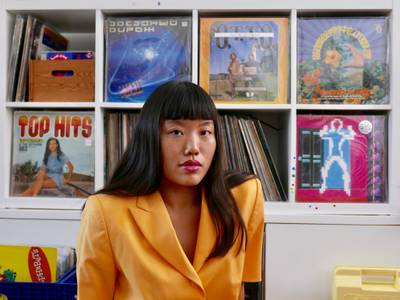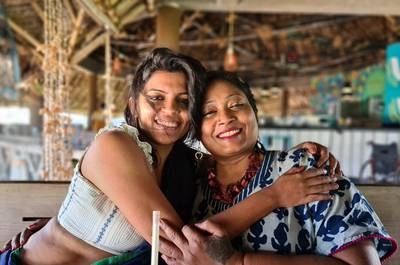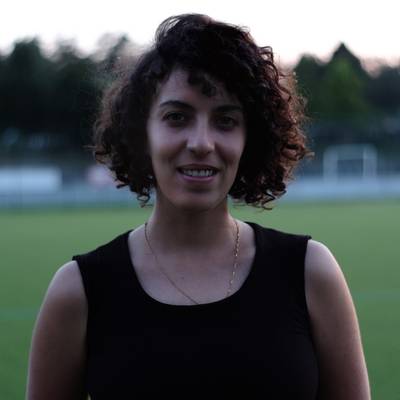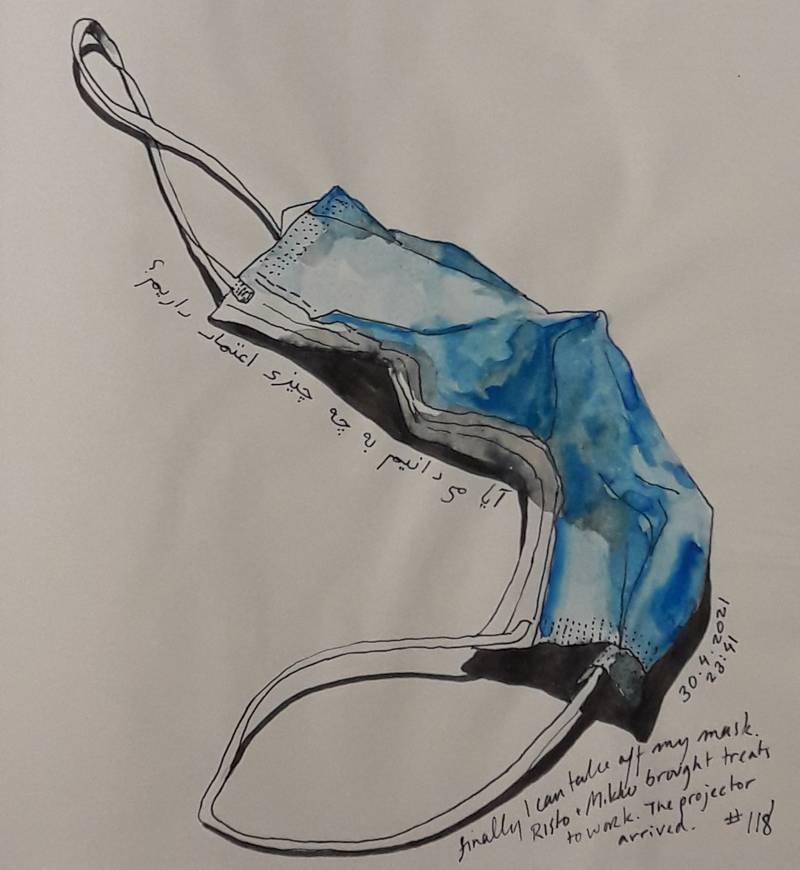

daily drawing #118 by Anna Ruth
Egle Oddo is a visual artist interested in operational realism, meant as the presentation of the functional sphere in an aesthetic arrangement and its inter-relations. Her work is present at international biennials, museums and relevant institutions, as well as cutting edge and independent alternative spaces and events.
Anna Ruth tells how curating from the perspective of an artist creates structures of care and reciprocity.
This interview is a transcription from a recorded verbal dialogue that happened on a balcony while five other friends were eating, listening to music and dancing in the other room. In this transcription we wished to communicate the feeling of thinking through talking as it happens in real dialogues, holding a glass of red wine, sensing on our faces the fragrant sting of summer wind, on a late evening.
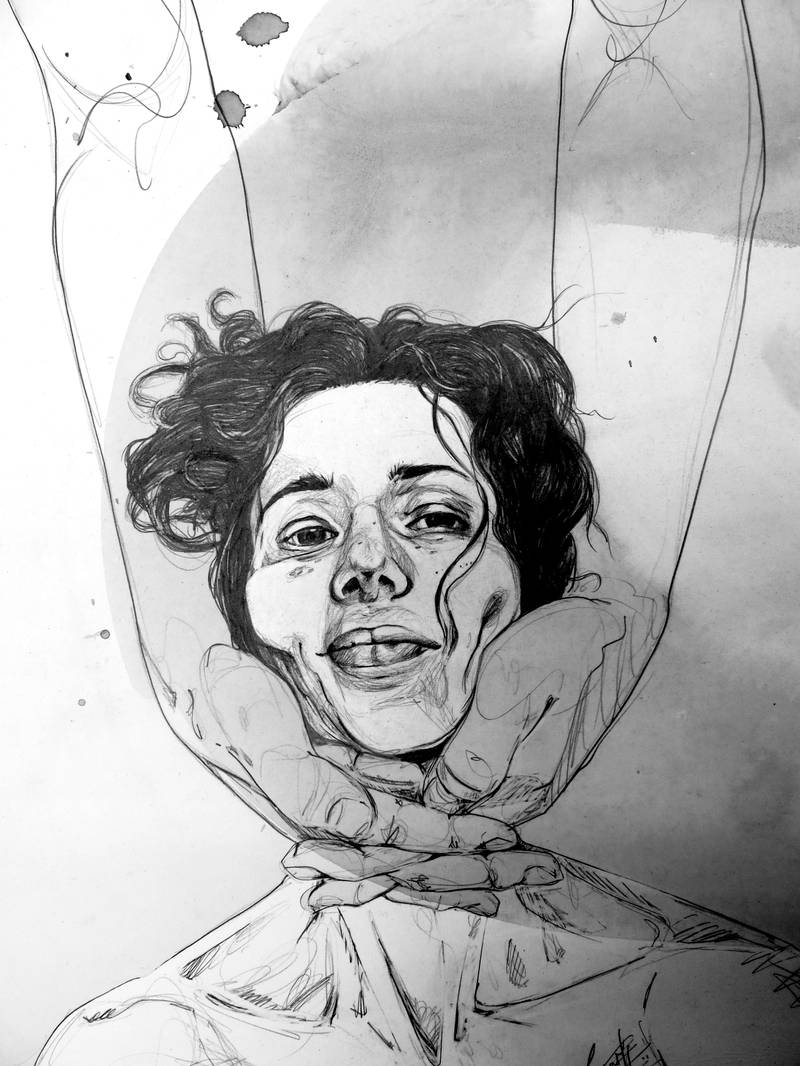

Portrait of Anna Ruth by Mariam Haji
EGLE: So we are in Mänttä, it is July 30th 2021 and it’s almost two months after the opening of the Art Festival in Pekilo.
ANNA: Yeah, basically a month and a half after the opening.
Yes, and I’ve been thinking through the questions and also in which kind of sequencing I wanted to ask them and I took some notes, so let’s see. Tell me about your drawing diary. What has meant for you to make one drawing every day and to share it?
Oh, thank you for asking about that. At the beginning of the year when a lot of people make promises and resolutions. I was reading about people who are starting a diary of different kinds. I thought I could start a diary recording things that are happening, just anticipating that this year would be a big year for me with the installing of Mänttä, and I wanted to do something a little bit for myself as well and something that continued my practice as an artist and not just as curator, but really wanted to get back into doing stuff as an artist. So I decided to do a daily drawing which actually is not a new thing for me, a few years ago I did a ten years project where I did two drawings a day for ten years. They weren’t very elaborate drawings, sometimes it was just a line, it was just a practice, I was calling it “medicine drawings” like take two pills before bed basically. But this time I wanted to do it a bit differently and really focus on drawing. So yeah, this time as well another thing that influences the drawings is that I’m putting them online so that creates a kind of pressure to make it happen, and to make it happen on time, which is an incentive to make it happen, it might happen actually…
(Anna has an ironic look)
(Egle laughs)
…cause there is a lot, and, there is a lot in there, cause this time is about the drawing practice, slowing down, focusing half an hour a day on drawing, but then there is also the diary form of recording what is actually happening in the moment, so I write, ( ahem ), in English a little something about what happened that day, sometimes it is a list of things that happened, sometimes it gets a bit more personal or emotional, just something about that day. So there are those two elements and there is also a third element, and … and ( umm ), it is a little bit tricky… especially cause it’s online and it’s more – for me, it’s more intimate, but I add a phrasing in Fārsi, which may seem a bit strange. I’m learning Fārsi, for personal reasons, and I thought that that is a really good way for practising when I don’t have a lot of – I feel I don’t have a lot of time. This year I don’t feel I have a lot of time to do extra things, to study or whatever, but then I write this phrase every day, so I have been practising some way and then incorporating that language and incorporating it into my practice. So these are the three aspects, and this is technically how it is working.
And the feedback you receive online?
Ummm, well actually, I write by hand so at first, I thought that nobody would actually read it, but there are quite a few people who actually read what I’m writing, and sometimes people comment on it. If I write something a little bit too personal, people might comment, like if I say I’m having a bad day. There isn’t a lot of feedback per se, but some random comments might happen and some random hearts or fires…
It’s on Instagram.
It’s only on Instagram, yeah on Instagram story, and then I save them so they are all in there.
Are you looking forward to going to your studio and work? And what is your research about, at present?
Yea! I am, I am, I would really like to. (Anna almost screams)
I would like to… develop – I mean for me creating is in a way painful, mmm, it’s not, it hasn’t been like a joyful experience for me making art, and I’m not talking even like emotionally. I’m talking more – there is a lot of anxiety for me in making art that I have to overcome in order to make things. Which is why I usually set very strict rules for me to work within, so that I can overcome that anxiety and I can actually create. There are a lot of things that I have been saving, and I have a list that I’ve written down. There is a painting series that I want to work on and a couple of animations that I would like to do. The painting series I have seen in my mind, so I know what I wanna do: I wanna work with broken things, things that get broken and can not be fixed. I wanna paint a series from the daily drawings of eggs that I broke and fixed and put like (Anna laughs a bit embarrassed) tape on the eggshell. I thought I wanted to explore something like that, of broken things that can’t be fixed. It’s not clear yet what I’m doing with that and why. Or where I’m going with that. But I want to start and let’s see what happens, I have a bunch of paintings that I’m gonna paint over to do this series and if it doesn’t go anywhere I will just paint over those.
What are the broken unfixable things that you painted?
There were a few, there were some glasses… they are all physical objects. And most of them are – I was thinking that most of them end up being… non… like inanimate objects, except for the egg which was alive at some point but then… it is dead. Then it is already broken… I don’t know!? (Anna laughs gently with a smile)
Yea.
…There were plastic objects that you can’t repair. But I was thinking, I’d like to focus, I wanted to do a series, I was visualizing just a series of eggs, and to break different eggs and try to fix them, and yeah, just see where that would go. I think it fits in esthetically with some of the paintings that I have been doing, which is very – in a way more monochromatic. I use a lot of white, and a lot of space, so in that kind of colour aesthetic term it would be fitting.
Yea, white on white?
White on white. I have to see!
(Anna and Egle smile together)
When you observe the public observing the works, what do you think?
The works that are now in Mänttä or my works? Which works?
Mmmmm… First your works. And then… (Egle moves her finger indicating sequence)
So when I’m watching the public observe my work I’m looking for emotion, I’m looking to see if I can see something stir on their face, if I’m physically present and watching, watching their reaction. I am watching the amount of time that they are spending with the work. I’m looking a lot at the body language, their physical presence. That’s interesting. In a sense I’m looking at, I’m looking for clues that would tell me about their connection or their disconnection with what they are seeing. And I think it’s the same for the works in Mänttä. That’s what I’m looking for, hoping for, that some kind of connection, maybe some kind of visceral connection happens, some kind of energy… mmm… that people would spend time, and they would notice that they are spending time.
(Silence)
First I try to create a really good connection with the person. With the artist. With the workers. The builders. With everyone who is involved in creating the exhibition. That’s my first step to feel a connection, to feel a pull between people, and to feel out where people are drawn to, what people are drawn to, what they are trying for.
What types of bonds and bridges do you try to establish working as a curator?
Well, first I try to create a really good connection with the person. With the artist. With the workers. The builders. With everyone who is involved in creating the exhibition. That’s my first step to feel a connection, to feel a pull between people, and to feel out where people are drawn to, what people are drawn to, what they are trying for… I think it should be ok (Anna says referring to the phone recording this audio interview) … And then after that, what the artwork – of course, it’s really important for me to allow space for the artwork to say what it wants to say, but I also want to make a map so that the path that a visitor can take through the artworks pulls them through. There are elements that they recognize while they are moving, like marks on a trail, so that they can find their way through with regards to the artwork. Not necessarily spatially finding their way through, they can get lost, it’s fine, that would be kind of fun too, that you lose yourself in the space. But that the artwork is helping you to build a story in your mind as you are walking through. That’s what I hope to make. So, little hints, as you go through. That would be bridges and connections. I guess it’s intellectual bridges and connections, is what I’m looking for. And also maybe physical bridges and connections. But definitely, I don’t know if I answered that question.
Maybe some examples with some works that we have in Mänttä, examples that you are happy with with the connections between certain works so that we can have a visual reference to see what you mean.
Something very basic is that there is a ground feeling for the first floor. Things like earth, forest, human figures. So you enter through the forest and you arrive at a miniature forest, and then further on you are drawn to a more classical form of forest. So you have a hint of what it is, you see a visual of the original element and then you see a more abstract form of that same thing in a line. There are a few other pieces along the way that also create it as well. You have this landscape of the forest which is Pia Sirén’s work which I was mentioning before. So the first was Pia Sirén, then Jonna Suurhasko and Aaron Hiltunen. And then the next connection you could also make would be: you can go from Pia Sirén into Hanna Råst, their communication builds on the landscape, and then you can also come to Jonna’s work which is a miniature landscape, and then from there you go to Hanna ( uh ), I mean, Heidi Naumanen where she is using televised visions or in her ceramic televisions she has these digital paintings of forest landscapes, and the structure of that is also creating a horizon where the televisions are on top of each other and using the natural light. So they are pretty simple, really really straightforward connections. But then you could go also to the other side and you have Emma Fält and Roberto Fusco who have a work where they’ve made a choreography with a robot arm and then recorded the forms that sand has made with the aid of this robot and that goes into the work of Ari Pelkonen who is also working with a very similar concept of chance, of how you can put things together in multiple forms, and still come up with a new image every time. And every time it’s a form of error, but every time it’s also perfect. Looking at that connection, that then leads to a dance performance, which is the face. Then there is that line of lecture that can happen.
The space really dictated which artwork could go where, because I really wanted to provide the space that would make the work shine, each individual work shine in its brightest form. That was the most important thing for me, and that’s what directed where the work would go, but within that, we have these smaller chains, these maybe intellectual connections.
Mmm
And then there is also some work that is biblical like the work of Aino Kajaniemi, and then you go up to the third floor and there is this insight of Aino Kajaniemi’s work, if you take the elevator you can go right up to Aishe Vejdani and her work is also dealing with the biblical story of Eve and the first apple. So then you can, I mean this might not be obvious to everyone but I have that connection that I’m using. And below, there is the work of Emma Fält and Roberto Fusco who have created a kind of cave in which you face a kind of creation story, the birth of the universe. Then you have that narrative. I can go through the whole exhibition. There are these links that have been important for me to create. And there are some things that felt really right like there were locations for certain artwork that felt like that was the only place where the artwork could be in. The space really dictated which artwork could go where, because I really wanted to provide the space that would make the work shine, each individual work shine in its brightest form. That was the most important thing for me, and that’s what directed where the work would go, but within that, we have these smaller chains, these maybe intellectual connections. That at least in my mind, make a path or mark the trail through the exhibition.
This is very interesting to read the neuronal connections that you have gathered around the works. I think this is the most interesting part because it’s not obvious. Of course, when one enters in the space the feeling of coherence is strong, and it’s a beautiful feeling of coherence, it’s not coherence as lack of freedom or something limited. It’s coherence in the sense of: “I understand where I am and I am here for a reason”. And as a viewer, to feel you are there for a reason immediately opens your senses. But of course, not everybody can imagine the neuronal connections you have, and that you have been making all the time between the works. This is very interesting.
I’m so happy that you felt that, and that’s also really important for me too. I mean even with the fellow artists that I have been discussing with, and influences that I have in Finland, talking about art with different people, the creation of a safe space within art is very important and that’s something I wanted to focus on as well in this exhibition. That when you enter the space you feel safe, you don’t feel attacked by the artwork, and you don’t feel confused or triggered by what’s there, but you feel a sense of security… so that exactly, you can feel open and you can actually start being open. Once you are open you can start seeing things in a new way and you can start accepting other possibilities and new visions. By getting closer to the artwork you can start making those connections.
Mmm, yea that makes sense.
I’ve been influenced by my experience working with Catalysti and Globe Art Point, and also extremely influenced by NO NIIN. I’m not saying that because this is going in there but I really respect the humanity with which – these artists are really pulling towards. Because I think this is the only way we can really exist and move forward. It is through these real human connections.
Yea, yea definitively.
(Silence. They giggle a bit, then the sound of a page turned)
Ah! Do you know that a lot of people in Helsinki says that To Err is Human is much more coherent and well compiled than the Helsinki Biennial?
(Anna laughs with a slightly naughty and pleased tone)
I heard that today, and I can’t comment because I haven’t seen the Helsinki Biennial. But there are a lot of things that happen outside of Helsinki. (Anna and Egle laugh wildly and loudly). There are actually a lot of good things that happen. And just because something happens in Helsinki it doesn’t necessarily mean that it has to be of the best quality. But I have seen some pictures that look really amazing, some amazing work, but a lot of what makes an exhibition successful for me is how I feel there, how it allows me to feel tired or to feel energized, or inspired or to help me connect with an artwork. So, I don’t know.
Well I’ve seen both. (They laugh again together). And connecting with what we said before, I didn’t feel any reason to be there, although I appreciated a lot several of the individual works and how they were conceived, realized, installed, everything. But there was not a compelling reason for me to be there, at least not suggested by the discourse of the exhibition. The discourse meaning all the works together, the body of works together.
I hope I can get to see it.
It’s interesting and of course it’s the first Biennial.
It’s groundbreaking to make a whole new festival like that.
Absolutely.
It is a huge job, I hope they have enough people on their teams.
I hope so. Because as we know, also Mänttä is not an easy show. Normally it’s prepared in one year, it’s a lot of artists. It’s not because it’s not a Biennial that it’s easier, it’s a lot of work…
There is a lot going on, a lot of pressure and negotiations going on within the institution and there is a lot of focus on how the festival itself is never the same. But at the same time as it comes from within such a strong structure there forcibly is a pattern, which is ultimately controlling. There are elements that are controlling the visuals, there are promotional elements trying to brand the festival, and for me personally, those are elements that are very difficult to work within. They don’t necessarily represent my values or the values that I want to represent in the exhibition. But they have to be taken in because they are pulling towards the promotion. As I’m saying it now it sounds really conflicting which is how it feels sometimes. But yea, it is these continuous kinds of compromises. To find, where is my place. Am I standing where I want to be standing? Are there possibilities to work with this or is it something that I should fight, ultimately?
The Mänttä festival exists now for twenty-five years.
It’s more. This is the 25th festival but it has existed for thirty years.
And Helsinki Biennial has existed for one year, so of course it has yet to build a sort of brand, let’s say, or identity. I think that the identity of Mänttä is both a strength and a limitation.
As I learned more recently there was a much more guerilla starting point at the beginning of the Mänttä festival. It was very much volunteer work, basically all-volunteer work with no money and piecing things together as a group. A lot of community work, and a little bit edgy. I guess like anything that grows it becomes more conservative in a lot of ways. So the festival is slowing down, not as rebellious …
Interesting! (Egle interrupts Anna) Biennial started as very conservative, so maybe they will drift to guerrilla.
(They both giggle in disbelief)
At some point. Give it some time to rebel.
(Silence)
What does it mean to work in relation to and in collaboration with?
Mmmmm… ‘In collaboration with’ is about listening. Listening to what the other needs, and to be working with that need, towards those needs to make it happen. This is coming from my position as a curator when I work in collaboration with. I accept my position of power as a curator and therefore my position is to listen and to try to focus on what the need of my collaborator is, in order to work towards their needs. ‘In relation to’ it would be, as curator, a relationship that is not necessarily – not a different kind of position, maybe… Yea, I’m not really sure what it is to work in relation to, maybe I would need an example.
For example, if you are working in relation to the concept of ‘error’…
Right.
…Or if you are working in relation to the local community in Mänttä. Or if you are working in relation to your own conception of your identity and what this conveys.
That also implies a lot of listening…
We are recording things here! (Egle says towards friends moving around loudly. The balcony squeaky door closes behind chatty voices)
Yea, ‘in relation to’ also implies a lot of listening as well but I’m more on an active role. I am actively creating connections. So ‘in collaboration with’ I need to listen and then work within that information that I’m gaining. And ‘in relation to’ is something that I’m trying to gain, I’m reaching out. That’s how I would describe it. I’m receiving ‘in collaboration’ and ‘in relation’ I’m asking or looking for. At this moment this is my definition, tomorrow might be different.
What has this experience in Mänttä given to you, and what has it changed inside of you?
Oh! Oh, hoh, hoh, hoh … Yea.
(Silence)
…Well, it actually has been giving me a different kind of confidence. Because in a lot of ways… We are recording.
I realized as well that by not assuming it I wasn’t doing a favor to anyone, and least of all to myself, but anyone else either. It came to a point that I had to acknowledge that I had to take that position of power and find my own way to use it that could, hopefully, be beneficial to others, as well as to myself.
Friend’s voice: Oh shit.
Starting out, it was very ominous the position I was given and I wasn’t able to see or to acknowledge the power of the position I was in. I wasn’t able to assume that. It was difficult to realize that I needed to assume that position, I needed to take that power in order to make it happen. And that was a really hard thing to do because I didn’t want to assume that power and I had an inner struggle with that. But it was much easier once I did it, once I was able to accept that. I realized as well that by not assuming it I wasn’t doing a favor to anyone, and least of all to myself, but anyone else either. It came to a point that I had to acknowledge that I had to take that position of power and find my own way to use it that could, hopefully, be beneficial to others, as well as to myself. That’s something that I gained and through that came a different kind of self, a different kind of confidence just in being. I didn’t have to run away from power positions or ignore those privileges, but actually assume them and try to use them for a positive impact.
I can relate a lot with what you say.
It’s hard. It’s super hard.
I find it problematic when, also among curators, when this position is not taken. In general when there is the mental stance of “Oh, any position of power is bad, so I will refuse everything”, this gives even more space to those that in fact will use power badly.
…And then you are not defending those who need defending. I mean, not everyone needs defending, but your position of power enables you to see who needs it. As opposed to who is taking the power. Once you are able to see that, you are able to function more clearly. In this exhibition, it was really important for me to build the team so that we would feel that we are doing this together. In this sense, I was taking my power. I wasn’t trying to use it as a way to suppress other people and to show it, but as a way to allow space for the people who needed more space. Time, support for those people. And because I was in a position of power I could allot time to those people and support those people, because I was a step back and we weren’t on even ground. It was a super difficult thing to come through, to find, to acknowledge and to accept, and to move forward. I am grateful for this opportunity, for the growth.


daily drawing #216 by Anna Ruth
It was beautiful to see you doing this from my perspective. And the fact that you did it, and you did it gracefully, it helped me to grow with my work as an artist.
Wow.
I know the point where the work has improved because I was not disturbed, I was supported. And in most cases, unfortunately, as we all have experienced as artists, you do it but with a lot of transversals, non-necessary, other things.
…Other things that don’t belong to the artist. That’s also something that I’ve enjoyed, that I’m a visual artist myself and so I’m able to have that perspective. I have that experience of what it feels like to work with other people with their own agendas. They are trying to push you into their direction, which can be – I mean, maybe, in the end, you want to go in that direction, but you don’t want to feel forced into that direction, because it might be too soon. When you are given enough time, enough space, you get better results and closer to what you were hoping for, instead of if you push it. At least this time it worked this way. Maybe I won’t work like this every time, but at least this time it worked out. There are a few examples of things that I felt “Arg, I don’t want this to be like this!”, but then I gave the artist time to go through their process and I would just wait. Just wait. And in every case, it resolved itself without any conflict. (Silence) I will be so sad, such a good community that we have here altogether, it will be like, oh gosh what’s next?!
(Anna smiles and looks away)
We all move to Jyväskylä. You would go: “Nooo, go away!”
(Anna laughs covering her face with her hands. Sound of two wine glasses toasting)
I’m sure if you would organize something in Jyväskylä you would have at least forty to forty-seven artists coming… The number is not referring to anything in particular. (Winks)
Just a random forty-seven artists.
(They both laugh with joy)
Something special for me was that I didn’t know everyone before, and a lot of people I knew remotely. I had heard of them but I never met them, and then there was probably a third that I had never met at all and didn’t know anything about them. And that was really exciting. To have that fresh community in that way.
Yo! I think we have it. Is it good? Those were my seven questions.
Yea. And we spoke for forty-five minutes.


